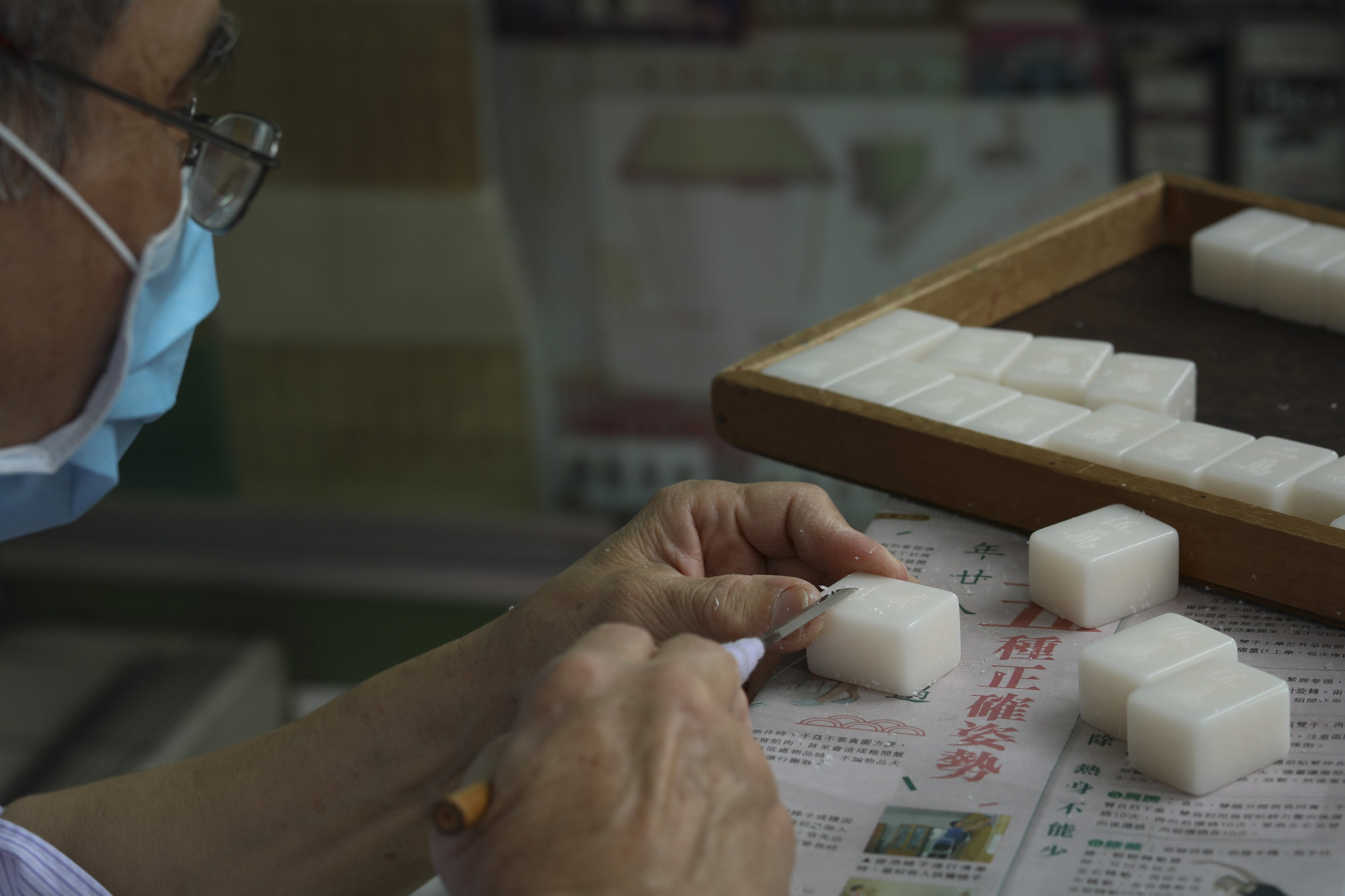
Hand-carved mahjong tiles ‘part of the Hong Kong story’: plight of craftsman facing eviction from stairwell store sheds light on dying art form
- Third-generation owner of Biu Kee Mahjong in Jordan says landlord is forcing him to move out over non-compliance with building standards
- Lawmakers urge ‘special arrangement for special case’ out of consideration for craft as one of city’s heritage gems
Cheung Shun-king is one of a handful of Hongkongers involved in hand-carved artisan mahjong tiles, a tradition passed down through three generations, but he might be forced to close his store and risk the demise of his unique craft.
Mahjong tile-making was in 2014 listed as an intangible cultural heritage by an office under the Leisure and Cultural Services Department, with the mission being to safeguard and support the transmission of the technique.
“Of course I don’t want to retire. I’ll be happier if I could stay at my store and carve tiles every day,” said Cheung, 71, the third-generation owner of Biu Kee Mahjong located under a stairwell in Jordan. He estimated there were fewer than 10 people in his profession citywide.

Cheung recalled his landlord walking by the store on September 29 and telling him he needed to move out before November 2 because his set-up had violated the Building Ordinances. The landlord did not elaborate.
“I was having my lunch at that moment and I totally lost my appetite. I felt very apprehensive about the future,” Cheung said, adding the landlord refused to talk the next day and told him to contact his lawyer.
“But when my children called the lawyer a few days later, he also refused to talk without his client’s approval,” Cheung said. “I rang the landlord again that night, he told me to leave before the end of October.”
A letter dated September 14 and seen by the Post showed the Buildings Department had on May 27, 2021, ordered that certain works on the premises be completed before July 26, 2021, including on a structure in front of the stairs, as well as Cheung’s store, that obstructed escape in the event of danger.
It said the owners had failed to complete the required works without a reasonable excuse, and legal proceedings against them for non-compliance were being considered.
The Leisure and Cultural Services Department declined to comment on the case upon a Post inquiry, but said the mahjong tile-making technique was one of 480 items on the first intangible cultural heritage inventory of the city. It added it had approached another mahjong store in Hung Hom to collaborate on an exhibition to promote the craft.
How did mahjong become so popular in the US?
A Buildings Department spokesman said it had issued a removal order to the owners in May 2021 after finding in an inspection that unauthorised structures in the stairwell store were affecting fire safety.
He added the department had informed the building owners and the tenant about the issues, but an investigation in August found that they had not complied with the changes requested in the order.
“If the owners had given reasonable suggestions to the department through construction professionals to ensure safety, the department would have been willing to consider keeping the stairwell store,” he said.
However, Cheung said he was not approached by any staff from the Department.
“I totally understand the difficulties of the Buildings Department on safety issues, but I just hope to stay here if the landlord is willing to cooperate with the department and find a balance that makes everyone happy,” Cheung said.

After the 1980s, the manual process of carving mahjong tiles was gradually replaced by machines that offered low costs and high efficiency.
Electronic mahjong tables that automatically shuffled and stacked tiles appeared in the late 1990s and further weakened the need for traditional craftsmanship.
Since then, the remaining mahjong carvers in the city mainly focus on renewing and recolouring tiles. They keep their craft alive by teaching at workshops as well as creating tourist souvenirs and customised tiles, which is what Cheung has been doing.
Cheung started his trade when he was a teenager after he graduated from secondary school and was asked to help with the family business.
“I’ve never officially been someone’s employee except for a few days of a summer job. Three or four decades ago, our business was thriving and we needed to outsource our jobs to other carvers,” Cheung recalled.
Hong Kong vice-chancellor hits out at students playing mahjong on campus
A full hand-carved mahjong set costs HK$5,500 (US$701). Cheung reaches out to more people on a Facebook page, with foreigners comprising 40 per cent of clients.
“Some of them even come back for a few more sets. And the biggest deal I had was almost 30 sets from one customer buying gifts for friends,” Cheung said, adding he was still working on two sets meant as dowry for customers and due in November, despite his uncertain situation.
He has no plans for his children to take over the craft or continue his business if his store closes.
“The cost is getting higher. There is no way to sustain the business. I have not heard of a mahjong-carving store opening in the past two decades,” Cheung said.

Chan Hoi-yan, a lawmaker and a member of the Intangible Cultural Heritage Advisory Committee under the Leisure and Cultural Services Department, urged authorities to support such businesses if closures were not due to financial difficulties.
“Not many people know how to carve a mahjong tile nowadays. The craft is one of our treasures,” Chan argued. “It’s not too late for the government to step in to help. We have places for cultural development.
“It’s crucial to keep the tradition alive if the government has pledged to tell the world the good stories of Hong Kong.”
Mahjong exhibition reveals gambling industry that once dominated Hong Kong
Jimmy Pang Chi-ming, a cultural critic, recalled the golden age of the practice in the 1980s, when people could hear the shuffling of mahjong tiles through neighbours’ walls.
“Sales of handmade mahjong sets were pretty good when the game was still popular back in those days. It also helped store owners keep their businesses afloat,” Pang said.
“The mahjong set epitomises the ‘made in Hong Kong’ label. People would bring along a set when they moved to other countries during the emigration wave in the 1990s.”

With diversified choices of entertainment nowadays, mahjong held less priority, especially since young people did not see a potential career in the craft, Pang said.
Lawmaker Scott Leung Man-kwong said Cheung’s situation could be a “special arrangement for a special case” for the government to balance building safety issues with the preservation of an intangible cultural heritage.
“It’s important to keep the craft alive, especially with the country’s 14th five-year plan supporting Hong Kong in developing into a centre for cultural and art exchanges between China and the world. Hand-carved mahjong tiles could be our unique symbol,” Leung said.


